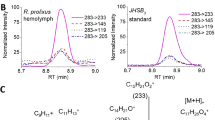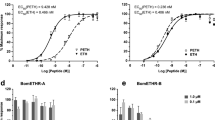Abstract
THE traditional method of determining whether an endocrine gland in an insect is active or inactive is to see whether it produces a hormonal effect when it is transplanted into a suitable test insect. An alternative is to inject the insect with some labelled compound in order to detect differences between the metabolism of the active and inactive glands1. The work described in the present communication uses a third method: comparing zymograms of active and inactive endocrine glands. The endocrine organ used was the brain of the cecropia silkworm. Insect brains secrete an agent called “brain hormone” which activates the prothoracic glands and causes the insect to moult. In the cecropia silkworm the brain ceases to secrete this prothoracotrophic hormone immediately after pupation, and the pupa enters diapause. The brain can be re-activated by exposing the pupa to temperatures between 5° C and 10° C for two or more months. Within a few days after they are returned to room temperature the brains of such previously chilled pupae start to secrete brain hormone; the prothoracic glands become activated; and diapause is terminated by the initiation of adult development2. This communication describes esterase differences between the zymograms of inactive and active brains.
This is a preview of subscription content, access via your institution
Access options
Subscribe to this journal
Receive 51 print issues and online access
$199.00 per year
only $3.90 per issue
Buy this article
- Purchase on Springer Link
- Instant access to full article PDF
Prices may be subject to local taxes which are calculated during checkout
Similar content being viewed by others
References
Oberlander, H., Berry, S. J., Krishnakumaran, A., and Schneiderman, H. A., J. Exp. Zool., 159, 15 (1965).
Williams, C. M., Biol. Bull. Woods Hole, 103, 120 (1952).
Smithies, O., Biochem. J., 61, 629 (1955).
Markert, C. L., and Hunter, R. L., J. Histochem. Cytochem., 1, 42 (1959).
Berry, S. J., Krishnakumaran, A., and Schneiderman, H. A., Science, 146, 938 (1964).
Van der Kloot, W., Biol. Bull. Woods Hole, 109, 276 (1955).
Author information
Authors and Affiliations
Rights and permissions
About this article
Cite this article
OBERLANDER, H., SCHNEIDERMAN, H. Esterase Changes during the Activation of Pupal Brains of the Saturniid Moth, Hyalophora cecropia. Nature 212, 432–433 (1966). https://doi.org/10.1038/212432a0
Issue Date:
DOI: https://doi.org/10.1038/212432a0
Comments
By submitting a comment you agree to abide by our Terms and Community Guidelines. If you find something abusive or that does not comply with our terms or guidelines please flag it as inappropriate.



